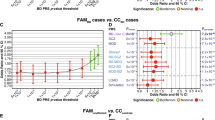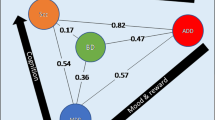Abstract
Markers near the nested genes G72 and G30 on chromosome 13q33 have been implicated in the etiology of schizophrenia and, recently, bipolar affective disorder (BPAD). Hattori et al (2003) reported that single-nucleotide polymorphisms (SNPs) near the G72/G30 locus were associated with BPAD in a sample of 22 pedigrees, and that SNP haplotypes were associated in a second, larger sample of triads. The present study attempts to replicate this finding in an independent case–control sample. Six SNPs near the G72/G30 locus, including the most strongly associated markers in the previous study, were tested in 139 cases and 113 ethnically matched controls. Significant association was detected between BPAD and two adjacent SNPs (smallest P=0.007; global P=0.024). Haplotype analysis produced additional support for association (smallest P=0.004; global P=0.004). Analysis of 31 unlinked microsatellite markers detected no population stratification in the cases or controls studied. Although the associated alleles and haplotypes differ from those previously reported, these new results provide further evidence, in an independent sample, for an association between BPAD and genetic variation in the vicinity of the genes G72 and G30.
This is a preview of subscription content, access via your institution
Access options
Subscribe to this journal
Receive 12 print issues and online access
$259.00 per year
only $21.58 per issue
Buy this article
- Purchase on Springer Link
- Instant access to full article PDF
Prices may be subject to local taxes which are calculated during checkout

Similar content being viewed by others
References
Taylor L, Faraone SV, Tsuang MT . Family, twin, and adoption studies of bipolar disease. Curr Psychiatry Rep 2002; 4: 130–133.
Prathikanti S, McMahon FJ . Genome scans for susceptibility genes in bipolar affective disorder. Ann Med 2001; 33: 257–262.
Craddock N, Dave S, Greening J . Association studies of bipolar disorder. Bipolar Disord 2001; 3: 284–298.
Chumakov I, Blumenfeld M, Guerassimenko O, Cavarec L, Palicio M, Abderrahim H et al. Genetic and physiological data implicating the new human gene G72 and the gene for D-amino acid oxidase in schizophrenia. Proc Natl Acad Sci USA 2002; 99: 13675–13680.
Detera-Wadleigh SD, Badner JA, Berrettini WH, Yoshikawa T, Goldin LR, Turner G et al. A high-density genome scan detects evidence for a bipolar-disorder susceptibility locus on 13q32 and other potential loci on 1q32 and 18p11.2. Proc Natl Acad Sci USA 1999; 96: 5604–5609.
Potash JB, Zandi PP, Willour VL, Lan TH, Huo Y, Avramopoulos D et al. Suggestive linkage to chromosomal regions 13q31 and 22q12 in families with psychotic bipolar disorder. Am J Psychiatry 2003; 160: 680–686.
Hattori E, Liu C, Badner JA, Bonner TI, Christian SL, Maheshwari M et al. Polymorphisms at the G72/G30 gene locus, on 13q33, are associated with bipolar disorder in two independent pedigree series. Am J Hum Genet 2003; 72: 1131–1140.
Lander E, Kruglyak L . Genetic dissection of complex traits: guidelines for interpreting and reporting linkage results. Nat Genet 1995; 11: 241–247.
Ardlie KG, Lunetta KL, Seielstad M . Testing for population subdivision and association in four case–control studies. Am J Hum Genet 2002; 71: 304–311.
Simpson SG, Folstein SE, Meyers DA, DePaulo JR . Assessment of lineality in bipolar I linkage studies. Am J Psychiatry 1992; 149: 1660–1665.
McInnis MG et al. Genome-wide scan of bipolar disorder in 65 pedigrees: supportive evidence for linkage at 8q24, 18q22, 4q32, 2p12, and 13q12. Mol Psychiatry 2003; 8: 288–298.
Endicott J, Spitzer RL . A diagnostic interview: the schedule for affective disorders and schizophrenia. Arch Gen Psychiatry 1978; 35: 837–844.
Simpson SG, McMahon FJ, McInnis MG, MacKinnon DF, Edwin D, Folstein SE et al. Diagnostic reliability of bipolar II disorder. Arch Gen Psychiatry 2002; 59: 736–740.
Egeland JA, Hostetter AM . Amish Study, I: affective disorders among the Amish, 1976–1980. Am J Psychiatry 1983; 140: 56–61.
Dausset J, Cann H, Cohen D, Lathrop M, Lalouel JM, White R . Centre d'Etude du Polymorphisme Humain (CEPH): collaborative genetic mapping of the human genome. Genomics 1990; 6: 575–577.
Akula N, Chen YS, Hennessy K, Schulze TG, Singh G, McMahon FJ . Utility and accuracy of template-directed dye-terminator incorporation with fluorescence-polarization detection for genotyping single nucleotide polymorphisms. Biotechniques 2002; 32: 1072–1076, 1078.
Abecasis GR, Cookson WO . GOLD—graphical overview of linkage disequilibrium. Bioinformatics 2000; 16: 182–183.
Excoffier L, Slatkin M . Maximum-likelihood estimation of molecular haplotype frequencies in a diploid population. Mol Biol Evol 1995; 12: 921–927.
Devlin B, Risch N . A comparison of linkage disequilibrium measures for fine-scale mapping. Genomics 1995; 29: 311–322.
Lewontin RC . On measures of gametic disequilibrium. Genetics 1988; 120: 849–852.
Cordell HJ, Clayton DG . A unified stepwise regression procedure for evaluating the relative effects of polymorphisms within a gene using case/control or family data: application to HLA in type 1 diabetes. Am J Hum Genet 2002; 70: 124–141.
Fallin D, Schork NJ . Accuracy of haplotype frequency estimation for biallelic loci, via the expectation-maximization algorithm for unphased diploid genotype data. Am J Hum Genet 2000; 67: 947–959.
Kong A, Cox NJ . Allele-sharing models: LOD scores and accurate linkage tests. Am J Hum Genet 1997; 61: 1179–1188.
Guo SW, Thompson EA . Performing the exact test of Hardy–Weinberg proportion for multiple alleles. Biometrics 1992; 48: 361–372.
Pritchard JK, Stephens M, Rosenberg NA, Donnelly P . Association mapping in structured populations. Am J Hum Genet 2000; 67: 170–181.
McGinnis R, Shifman S, Darvasi A . Power and efficiency of the TDT and case–control design for association scans. Behav Genet 2002; 32: 135–144.
Schulze TG, McMahon FJ . Genetic association mapping at the crossroads: which test and why? Overview and practical guidelines. Am J Med Genet 2002; 114: 1–11.
Cardon LR, Palmer LJ . Population stratification and spurious allelic association. Lancet 2003; 361: 598–604.
Gordon D, Finch SJ, Nothnagel M, Ott J . Power and sample size calculations for case–control genetic association tests when errors are present: application to single nucleotide polymorphisms. Hum Hered 2002; 54: 22–33.
Mitchell AA, Cutler DJ, Chakravarti A . Undetected genotyping errors cause apparent overtransmission of common alleles in the transmission/disequilibrium test. Am J Hum Genet 2003; 72: 598–610.
Sun L, Cox NJ, McPeek MS . A statistical method for identification of polymorphisms that explain a linkage result. Am J Hum Genet 2002; 70: 399–411.
Long A, Lyman R, Langley C, Mackay T . Two sites in the delta gene region contribute to naturally occurring variation in bristle number in Drosophila melanogaster. Genetics 1998; 149: 999–1017.
Drysdale CM, McGraw DW, Stack CB, Stephens JC, Judson RS, Nandabalan K et al. Complex promoter and coding region beta 2-adrenergic receptor haplotypes alter receptor expression and predict in vivo responsiveness. Proc Natl Acad Sci USA 2000; 97: 10483–10488.
Acknowledgements
This study was supported in part by Young Investigator Awards from the National Association for Research on Schizophrenia and Depression (Y-SC and TGS) and by the National Institute of Mental Health Intramural Research Program (FJM and SDD). Sample collection was supported by grants from the National Institute of Mental Health, The Charles A Dana Foundation, and the Ted and Vada Stanley Foundation. We thank Elliot S Gershon for kindly making his manuscript available to us in advance of publication; Sylvia G Simpson, Dean F MacKinnon, and Susan Folstein for contributing to the clinical assessments and diagnoses; Tu Nguyen for assisting with data management; and the family volunteers, without whom this work would not have been possible.
Author information
Authors and Affiliations
Corresponding author
Rights and permissions
About this article
Cite this article
Chen, YS., Akula, N., Detera-Wadleigh, S. et al. Findings in an independent sample support an association between bipolar affective disorder and the G72/G30 locus on chromosome 13q33. Mol Psychiatry 9, 87–92 (2004). https://doi.org/10.1038/sj.mp.4001453
Received:
Revised:
Accepted:
Published:
Issue Date:
DOI: https://doi.org/10.1038/sj.mp.4001453
Keywords
This article is cited by
-
Genome-Wide Searches for Bipolar Disorder Genes
Current Psychiatry Reports (2011)
-
The DAOA/G30 locus and affective disorders: haplotype based association study in a polydiagnostic approach
BMC Psychiatry (2010)
-
Advances in molecular genetics of panic disorder
Molecular Psychiatry (2010)
-
A genome screen of 35 bipolar affective disorder pedigrees provides significant evidence for a susceptibility locus on chromosome 15q25-26
Molecular Psychiatry (2009)
-
Case–control studies show that a non-conservative amino-acid change from a glutamine to arginine in the P2RX7 purinergic receptor protein is associated with both bipolar- and unipolar-affective disorders
Molecular Psychiatry (2009)



